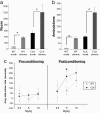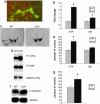Regulation of dopaminergic transmission and cocaine reward by the Clock gene
- PMID: 15967985
- PMCID: PMC1166621
- DOI: 10.1073/pnas.0503584102
Regulation of dopaminergic transmission and cocaine reward by the Clock gene
Abstract
Although there are clear interactions between circadian rhythms and drug addiction, mechanisms for such interactions remain unknown. Here we establish a role for the Clock gene in regulating the brain's reward circuit. Mice lacking a functional Clock gene display an increase in cocaine reward and in the excitability of dopamine neurons in the midbrain ventral tegmental area, a key brain reward region. These phenotypes are associated with increased expression and phosphorylation of tyrosine hydroxylase (the rate-limiting enzyme in dopamine synthesis), as well as changes in several genes known to regulate dopamine activity in the ventral tegmental area. These findings demonstrate the involvement of a circadian-associated gene, Clock, in regulating dopamine function and cocaine reward.
Figures




Similar articles
-
NAD+ cellular redox and SIRT1 regulate the diurnal rhythms of tyrosine hydroxylase and conditioned cocaine reward.Mol Psychiatry. 2019 Nov;24(11):1668-1684. doi: 10.1038/s41380-018-0061-1. Epub 2018 May 4. Mol Psychiatry. 2019. PMID: 29728703 Free PMC article.
-
VTA mTOR Signaling Regulates Dopamine Dynamics, Cocaine-Induced Synaptic Alterations, and Reward.Neuropsychopharmacology. 2018 Apr;43(5):1066-1077. doi: 10.1038/npp.2017.247. Epub 2017 Oct 17. Neuropsychopharmacology. 2018. PMID: 29039413 Free PMC article.
-
Effects of chronic cocaine exposure on the circadian rhythmic expression of the clock genes in reward-related brain areas in rats.Behav Brain Res. 2019 May 2;363:61-69. doi: 10.1016/j.bbr.2019.01.035. Epub 2019 Jan 22. Behav Brain Res. 2019. PMID: 30682435
-
Dopamine reward circuitry: two projection systems from the ventral midbrain to the nucleus accumbens-olfactory tubercle complex.Brain Res Rev. 2007 Nov;56(1):27-78. doi: 10.1016/j.brainresrev.2007.05.004. Epub 2007 May 17. Brain Res Rev. 2007. PMID: 17574681 Free PMC article. Review.
-
Circadian rhythms, the mesolimbic dopaminergic circuit, and drug addiction.ScientificWorldJournal. 2007 Nov 2;7:194-202. doi: 10.1100/tsw.2007.213. ScientificWorldJournal. 2007. PMID: 17982593 Free PMC article. Review.
Cited by
-
Methamphetamine and dopamine receptor D1 regulate entrainment of murine circadian oscillators.PLoS One. 2013 Apr 23;8(4):e62463. doi: 10.1371/journal.pone.0062463. Print 2013. PLoS One. 2013. PMID: 23626822 Free PMC article.
-
Association of PER2 genotype and stressful life events with alcohol drinking in young adults.PLoS One. 2013;8(3):e59136. doi: 10.1371/journal.pone.0059136. Epub 2013 Mar 22. PLoS One. 2013. PMID: 23533602 Free PMC article.
-
Circadian clock proteins control adaptation to novel environment and memory formation.Aging (Albany NY). 2010 May;2(5):285-97. doi: 10.18632/aging.100142. Aging (Albany NY). 2010. PMID: 20519775 Free PMC article.
-
Rhythms of life: circadian disruption and brain disorders across the lifespan.Nat Rev Neurosci. 2019 Jan;20(1):49-65. doi: 10.1038/s41583-018-0088-y. Nat Rev Neurosci. 2019. PMID: 30459365 Free PMC article. Review.
-
Endogenous dopamine regulates the rhythm of expression of the clock protein PER2 in the rat dorsal striatum via daily activation of D2 dopamine receptors.J Neurosci. 2010 Oct 20;30(42):14046-58. doi: 10.1523/JNEUROSCI.2128-10.2010. J Neurosci. 2010. PMID: 20962226 Free PMC article.
References
-
- Kowatch, R. A., Schnoll, S. S., Knisely, J. S., Green, D. & Elswick, R. K. (1992) J. Addict. Dis. 11, 21-45. - PubMed
-
- Watson, R., Bakos, L., Compton, P. & Gawin, F. (1992) Am. J. Drug Alcohol Abuse 18, 21-28. - PubMed
-
- Johanson, C.E., Roehrs, T., Schuh, K. & Warbasse, L. (1999) Exp. Clin. Psychopharmacol. 7, 338-346. - PubMed
-
- Baird, T. J. & Gauvin, D. (2000) Pharmacol. Biochem. Behav. 65, 289-299. - PubMed
-
- Roberts, D. C., Brebner, K., Vincler, M. & Lynch, W. J. (2002) Drug Alcohol Depend. 67, 291-299. - PubMed
Publication types
MeSH terms
Substances
Grants and funding
LinkOut - more resources
Full Text Sources
Other Literature Sources
Medical
Molecular Biology Databases

